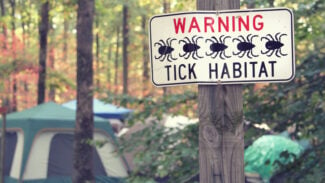Hiya Gorgeous,
One of my favorite things about living in the Catskills is taking long walks with my dog, Lola. But just this past weekend, we both came home covered in ticks. Lyme disease was my first concern. So far, we’ve both been lucky and fine, but I still need to be super vigilant about protecting myself and my beloved fur-kid. Lyme is one complex mofo. So today, we’re going to take a deep dive into this tick-borne bacteria and fully uncover all of its intricacies.
Lyme is called the “Great Imitator” for a couple reasons. First, it’s easily mistaken for other serious chronic conditions. Second, it’s been known to be at the root of many neuropsychiatric symptoms, from depression to anxiety to early dementia.
There are also different forms of Lyme. Acute Lyme happens when it’s caught early and treatment occurs within the first month of a tick bite. In these cases, it’s cured almost 75% of the time with antibiotics. But if an infectious tick bite goes unnoticed, it can lead to Chronic Lyme. In addition, Lyme bacteria can enter the nervous system and cause neurological issues. Plus, they typically travel with some co-infection buddies, like Babesia and Bartonella. The result? A wide range of chronic illnesses that are prevalent today.
Since 2013, there’s been a big increase in Lyme cases, with nearly 400,000 individuals a year infected with the disease (study). Blood tests are often unreliable and only detect about 50% of Lyme disease cases. So, there’s probably closer to one million cases happening each year. That’s a whole lot of people dealing with symptoms! So, let’s roll up our sleeves and truly understand this beasty. The more we know, the more we can prevent and treat it.
To help us understand Lyme disease and all its signs, testing options and treatments, I’ve turned to our wonderful friend, Richard Horowitz, M.D., a leading expert on Lyme disease who has treated over 12,000 chronic patients. His book, “How Can I Get Better? An Action Plan for Treating Resistant Lyme and Chronic Disease”, is one of the very best books on the subject.
As you can already tell, Lyme is complicated. So, it’s going to take a bit to unpack this topic for you. If this feels like too much information to take in at one sitting, bookmark this blog and finish reading it a little later. What’s important is that you take your time and make the most of this priceless knowledge. And if you know someone who would benefit from this information, please pass this blog along.
OK, let’s dive in and start with the warning signs…
Dr. Horowitz: The hallmark of Lyme disease is that the symptoms come and go with good and bad days, and the pain usually migrates around the body, whether it be joint pain, muscle pain and/or nerve pain (usually described as tingling, numbness, burning and stabbing sensations). Migratory pain is very specific for Lyme disease. You don’t see that with Chronic Fatigue Syndrome or Fibromyalgia, which can also both be due to a viral infection.
Other classic symptoms include hormonal fluctuations in women, where there are worsening symptoms around the menstrual cycle, as well as an improvement or worsening of symptoms with antibiotics (called a Jarish-Herxheimer reaction, which is an increase in symptoms as the bacteria are being killed off). Also, resistant fatigue (mild, moderate or severe), a stiff neck, headache, light and sound sensitivity, memory and concentration problems, word finding problems, sleep disorders (problems falling asleep and frequent awakening), chest pain and palpitations, as well as mood swings with an increase in depression and anxiety.
When Lyme affects the part of the body which controls the blood pressure, heart rate, bowels and bladder (called the Autonomic Nervous System), this can lead to symptoms of unexplained nausea, vomiting and chronic constipation, difficulty urinating, as well as dizziness standing associated with anxiety and palpitations (due to a drop in the blood pressure with a compensatory increase in the heart rate). This constellation of symptoms is referred to as POTS (Postural Orthostatic Tachycardia Syndrome)/dysautonomia (a dysfunction of the Autonomic Nervous System) and requires specific therapies to treat these symptoms.
If a patient complains of day sweats, night sweats, flushing, chills, air hunger (shortness of breath) and an unexplained cough, these are classic symptoms of a co-infection with Babesia, which is a malaria-like illness. Co-infection with Bartonella species can cause a new onset of a seizure disorder, unexplained eye symptoms with inflammation (iritis, uveitis, optic neuritis) and severe resistant neurological symptoms, including neuropathy (nerve pain/tingling/numbness) and an encephalopathy (cognitive difficulties). Bartonella patients may also have a distinct rash on various parts of their bodies. This can appear as red or white “stretch marks” over the chest, back, buttocks and lower extremities, which are either horizontal or perpendicular to the skin planes.
Dr. Horowitz: The major route of transmission of Lyme disease is through a tick bite, but only half of the infected individuals get a rash, and less than half of those present with a classic bull’s-eye rash. Many rashes look like solid red, spreading rashes, which can be confused with a cellulitis (infection in the skin) or a spider bite. Other borrelia species (like the newly discovered Borrelia mayonii) can cause diffuse and spotty rashes, so the type of rash depends on the borrelia species.
Another route of transmission of tick-borne diseases includes maternal-fetal transmission of the Lyme bacteria from a mother to child. This has been reported in medical literature and can lead to severe complications in the fetus. This is also true for co-infections, like Babesia and Bartonella, which can be transmitted from a mother to a child in the womb but can also be transmitted through an infected blood transfusion. Lyme can survive in a blood bank but has not yet been proven to be able to be transmitted by transfusion, although other borrelia species, like relapsing fever borrelia, can theoretically be transmitted with infected blood.
Another potential route of transmission includes sexual transmission of Lyme disease, but it has not yet been definitively proven. And finally, other routes of transmission of tick-borne diseases, like Bartonella, include bites from fleas, mites, lice, biting flies and spiders.
Dr. Horowitz: The standard two-tiered testing of an ELISA followed by a Western blot, which is used by the CDC, is known to be inaccurate. It will miss approximately half the clinical cases of Lyme disease. The diagnosis of Lyme disease is ultimately a clinical one. Even the CDC says this. The issue, of course, is how do you make the clinical diagnosis. The key point in making a diagnosis is to take a proper history and rule out other diseases that cause overlapping symptoms.
I have a questionnaire in my new book, “How Can I Get Better?”, that we validated with the help of SUNY New Paltz researchers, and we discovered that a score greater than 63 on the questionnaire statistically gave you a high probability of having Lyme disease. The key was to determine if the classical symptoms we discussed were present. When you use that score with an expanded testing panel for tick-borne disorders, you can usually make the diagnosis. I have a section in my new book that explains in detail how to do a differential diagnosis and use these tests if you have gone from doctor to doctor looking for answers and still find yourself chronically ill.










Great information and advice. What’s the most effective tick preventative treatment for my dog? I have tried organic controls with little success, unfortunately.
Check out my comment below. 🙂 xo, kc
We have had a lot of success with deterring ticks on our dog by using rose geranium essential oil. We use a blend of 15 drops of essential oil with 2 teaspoons of carrier oil such as grape seed oil or olive oil and put a few drops of the blend on her back between the shoulder blades and the base of her tail. As she doesn’t go in water very frequently, despite being a Labrador, we reapply it every 2 days, or more frequently if it’s raining. I haven’t found any ticks on our girl since we started using this about 6 weeks ago where as previously we were finding several a day.
Thanks so much for sharing this tip, Sharon! xo, kc
Great tip for dogs! Don’t use essential oils on cats though. Cat’s and essential oils do NOT mix (unfortunately)
Eva this is not accurate. Essential oils are actually fantastic for cats! There are some that are very toxic for cats like tea tree, some citrus oils and other “tree” oils. They will require a dilution of 1:100 and can be applied topically. Like most things, you might find info saying all essential oils are toxic out of fear based rational. Check out Dr. Janet Roark. Hope that helps ?
Hi Lexy
I’ve tried esential oils on my cats (even ones that said where suitable for cats!) and they all reacted badly. Even when i diluted them more than the advice 🙁
So i’m staying away from essential oils for my cats. Of course everyone , or should i say everycat, is different and you have a choice to use these or not. but i have to warn people when i read this because of my own and other cats in my neighbourhoud’s experiances. I’ve not yet found a cat that reacts well, so just be carefull please 🙂
Wow Kris, I just sent this to a few people suffering from this disease. Really informative. Thanks girlie:)
This was a great post, and very, very informative! One of my best friend’s dads died from a heart attack caused by misdiagnosed Lyme’s disease when we were teenagers, and I have been very proactive about prevention since.
My only question is that, since you mention your dog at the beginning, will you have a post covering prevention for dogs as well? I live in northern Illinois and camp in Wisconsin with my dogs, so I’m a firm believer in the Lyme vaccine for dogs, even if it’s efficacy is only 60-70%. It would still be helpful to know some tips and tricks to best prevent ticks to cover the other 30%!
Rose géranium essential oil is a good repellent that can be used on humans and dogs. Very effective.
Great tip for dogs! Don’t use essential oils on cats though. Cat’s and essential oils do NOT mix (unfortunately)
You may very well have just saved my life. I have ALL the symptoms. ALL. OF. THEM. I’ve begged docs to help me with the weird pains I get. They pop up anytime anywhere and can be like a stabbing pain, a vie-like gripping pain and what I call little comets making a shooting pain. I could never figure out if it was muscle, nerve or bone pain. I get all of them. They’re so intense sometimes they’ve brought me to my knees in the middle of Whole Foods. I’ve had heart palpitations too. I’ve gone to the doc convinced I was having a heart attack in slo-mo only to be laughed at by the sarcastic doc! I’ve been suffering, and I mean SUFFERING, for a good ten years now. NO ONE has done a thing to help me! I can’t STAND western docs. I refuse to ever go to one again. They’re all drug pushers, nothing more nothing less. I would be willing to see a Lyme specialist though. However, I am not taking any antibiotics. If I can heal the natural way I’m going that route. Thank you Kris. From the bottom of my heart, thank you.
Hi Deborah: I’m so sorry about what you’ve been through, but I hope that these resources will bring you answers and relief! You can do this—just take one step at a time. xo, kc
I’m the same Deborah! And i have had the same experiance with docters 🙁 I just don;t know if there is anyone in my neighbourhood that is a real lyme specialist. (some said they treated lyme before, but nothing worked for me yet)
I would loooove to be able to go to the doc in this article, but it is a bit far away since i live in The Netherlands 🙂
xx eva
If a great big huge hug could heal you…. you’d be healed right this second! 🙂 ((((((GREAT BIG HUGE HUG))))))
😀 thanks! big hug back 😀
Try him Eva, he has helped many people including myself! Good luck!
Christina
Xx
https://www.denatuurarts.nl/biografie
Thanks Christina!
I’ve just looked at the link and i see it is a 2 hour drive from my home to his. so it’s closer than the USA, but still very far :S
xxx
Can you go anywhere and request a Lyme Disease test? Or does it have to be ordered through your PCP?
Rose geranium essential oil is a great repellent. We used to get ticks whenever we had walks in the New Forest (renowned for it) but haven’t had any since using it. We put a drop on each ankle, each wrist, behind each ear.
Also good for dogs.
Wanted to pop in here & talk pets! Rose geranium oil is what we use too (for us and Lola). Here’s a few extra tips:
There are two kinds of rose geranium oils, from what I understand you want to go with the Pelargonium capitatum x radens variety.
Apply a few drops or make a spray mixture (20 drops of oil + 10 oz water). You can also add in a little citronella, lavender, lemongrass, eucalyptus, and cedar wood too. We usually buy a natural repellant at the health food store and then doctor it up with these oils. Keep in mind that a little can go a long way. Avoid your dogs face and be mindful not to soak their coat. Dogs have a much stronger sense of smell than we do so don’t over do it. xo, kc
I live in Maine and I have lyme disease,sjgrens syndrome , celiac, Graves, disease, lupus and I have a hard time eating right, I have gained a lot of weight this past winter, and I have been blue, let me know if you would like to take me on as a project and do a before and after, I really am inspired by you and feel as though I could really benefit from your help. I am 56 years old. Thank you for your consideration.
Thanks for the awesome info, Kris! I had Lyme disease (and possibly babesiosis) in 2011 and after the urgent care docs sent me down a reeeeally wrong path, I found much relief in a natural remedy called Lyme-Aid. I wrote a bit about it.
I was diagnosed with Lyme Disease in 2010 after 20 years of misdiagnosis. I’ve done antibiotic holistic and herbal treatment and am at a much better baseline than ever. The only thing that I can’t seem to reduce, is the associated anxiety, which has increased over the past few years. I recently tried PharaGABA which helped a little for a while and then didn’t seem to any longer. Any suggestions on treatment other than anti anxiety meds? Thank you!
http://www.tekenradar.nl in Holland there is a country-wide registration possibility when you are bitten by a tick. Every 2 month you can send in information about your healht condition. Very good initiative.
Thank you for raising awareness! Lyme Disease and its co-infections are awful and more people need to understand how serious it is. And Dr. Horowitz is great!